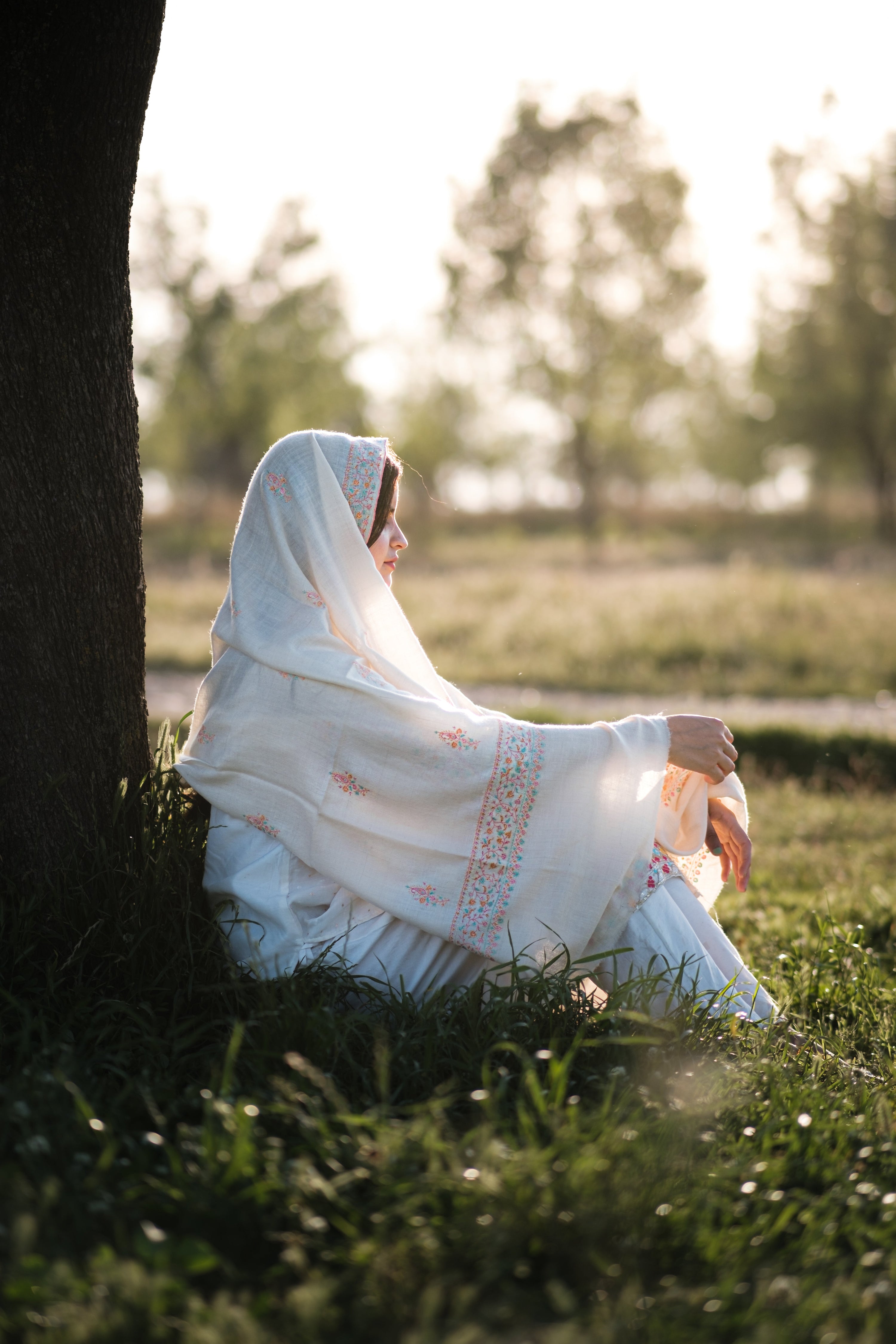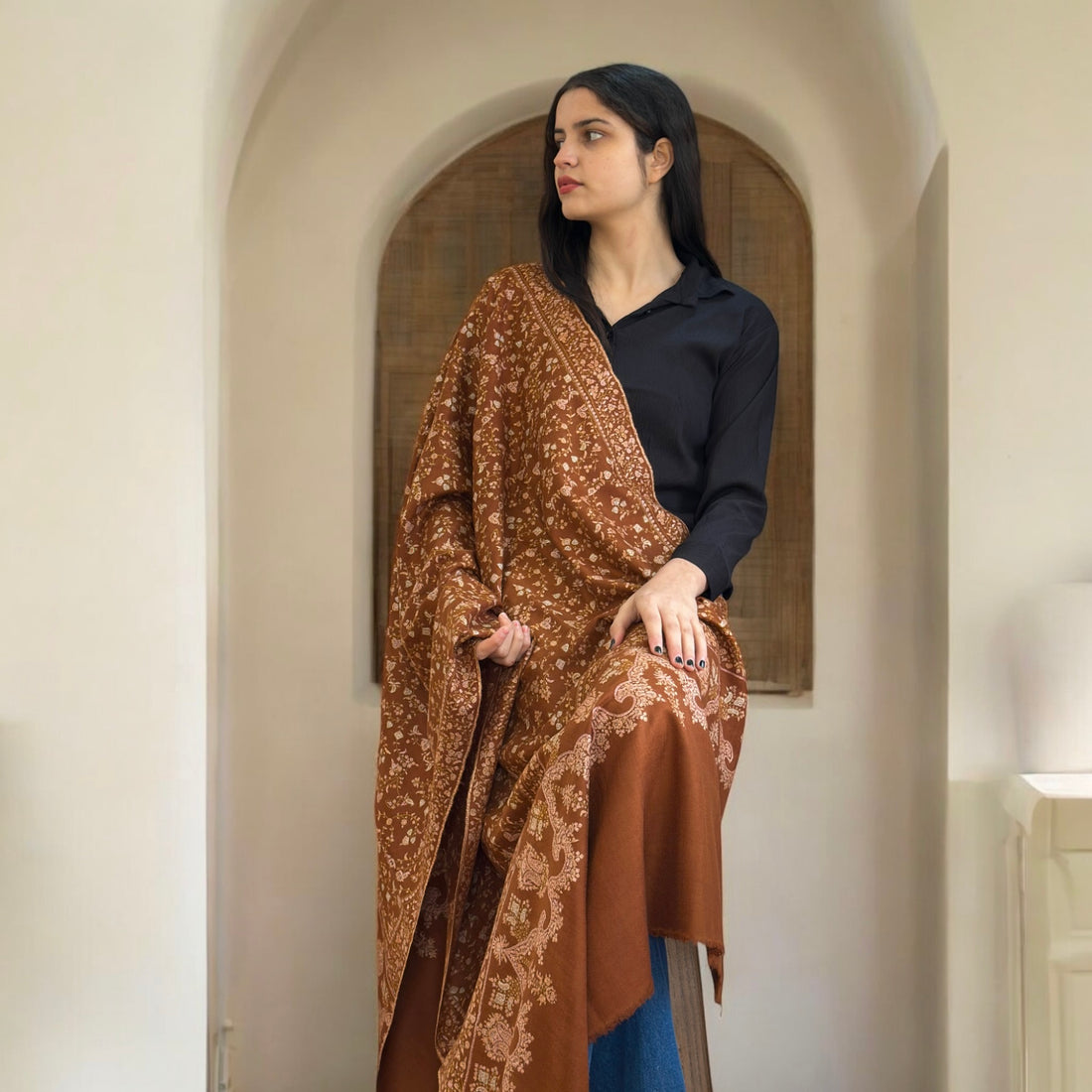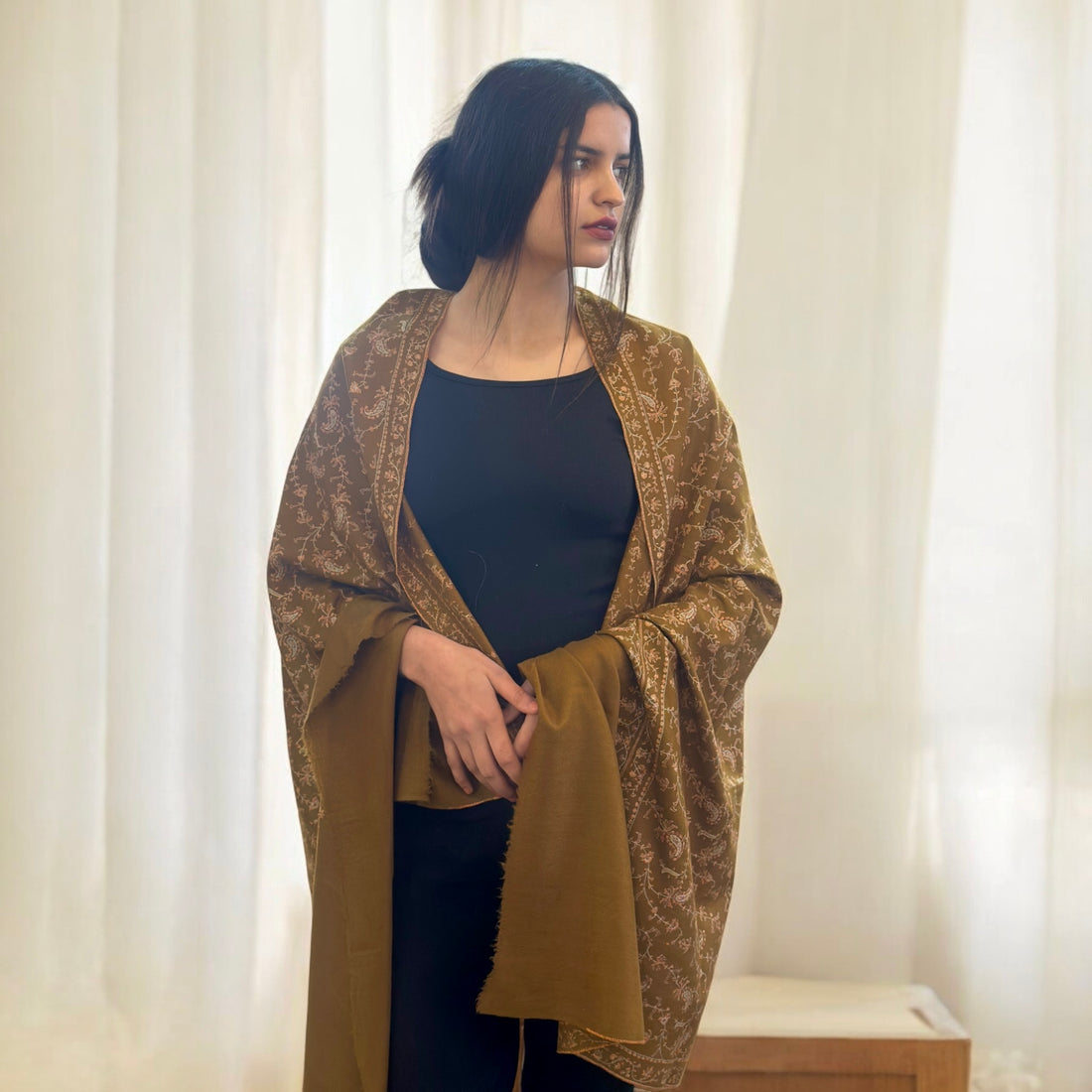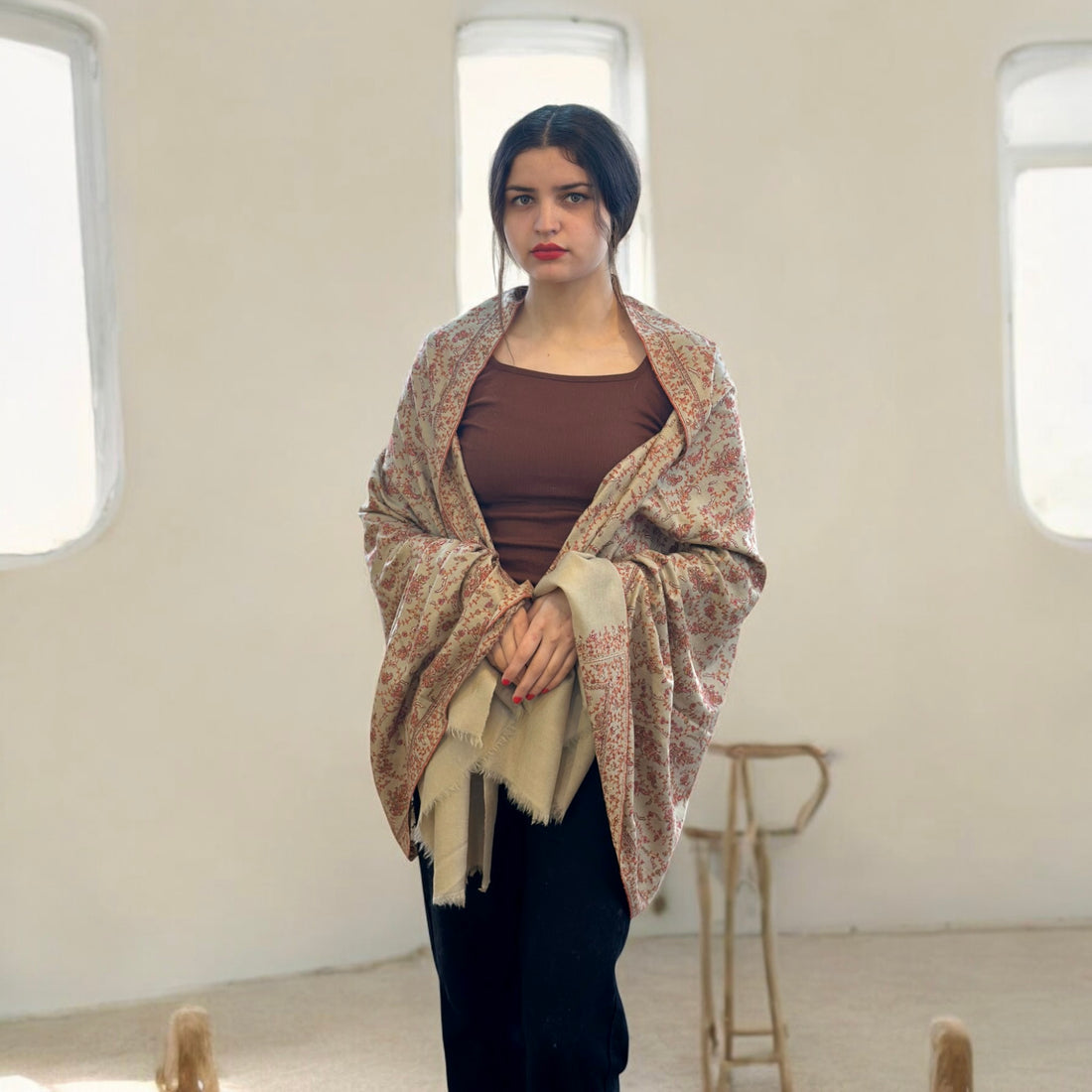High in the Himalayan mountains, a humble goat's soft undercoat would eventually make its way into the wardrobes of emperors and empresses. The story of Pashmina, the luxurious wool from which the famed Kashmir shawls are woven, spans centuries and continents. From early legends in the 14th and 15th centuries to the height of fashion in Mughal courts and Victorian parlors, the history of the Pashmina shawl is a journey of artistry, commerce, and cultural exchange. This blog traces that epic journey, showing how a craft rooted in the remote mountains of Kashmir became “an object of desire for neighbouring and distant elites” and eventually faced near extinction before finding new life.
Origins in the Himalayas: Legend and Early Beginnings
The exact origin of the Kashmir shawl is shrouded in legend. One popular tale credits the 14th-century Sufi saint Mir Sayyid Ali Hamadani with bringing fine goat wool (pashm) from Ladakh to the Kashmir Valley and encouraging local craftsmen to weave it into fabric. Another tradition points to Sultan Zayn-ul-ʿĀbidīn (also known as Zain-ul-Abidin) in the 15th century—he is said to have invited weavers from Turkistan to Kashmir, laying the foundation of the craft. While woolen shawls were mentioned as far back as the 3rd century BC and 11th century AD, the first specific references to the distinctive Kashmir Pashmina shawls appear in the 16th century during the Mughal era. By this time, Kashmir’s weavers had honed their craft, producing shawls of exquisite softness and beauty.
The Mughal Flourish: A Royal Fashion
Under the Mughal Empire (16th–18th centuries), the Pashmina shawl truly flourished. Mughal emperors fell in love with the feather-light, warm shawls. Emperor Akbar was so enamoured that he gave the Kashmiri shawl an affectionate name, parm-narm, meaning “supremely soft.” Shawls became a staple of courtly attire and prestigious gifts. Mughal elites and nobles draped themselves in Kashmir shawls as a symbol of status and refinement. The craftsmanship also evolved during this period, with intricate patterns (such as floral buta motifs) and techniques reaching new heights. By the 18th century, Kashmir shawls had become “an object of desire not only for Mughal Emperors and Sikh Maharajas, but also for Indian and Iranian nobles”— a coveted luxury beyond Kashmir’s borders.

Sikh and Dogra Rule: Industrial Strides Amid Political Shifts
The Sikh rule in Kashmir (early 19th century) marked a period of continued patronage for the shawl industry. Under Maharaja Ranjit Singh, the luxurious Kashmiri shawls became fashionable not only within the Valley but also found a thriving market in Punjab, particularly in Lahore, which emerged as a major trade hub. However, the final years of Sikh governance, especially between 1841 and 1845, were marked by political instability, including the weakening of central authority and regional conflicts. These disturbances disrupted the supply chains and labour conditions that supported shawl production, leading to a noticeable decline in output and trade. The landscape shifted again in 1846 with the signing of the Treaty of Amritsar, which transferred control of Kashmir to Maharaja Gulab Singh, the founder of the Dogra dynasty. This transition marked a new chapter for the Pashmina industry. That same year, Kashmir had approximately 7,000 operational looms and over 17,000 artisans engaged in shawl weaving. It bears testimony to the craft’s enduring significance in the regional economy. Yet, the recovery was not without its setbacks. In 1847, a combination of socio-economic pressures and uncertain governance led many skilled weavers to migrate to neighbouring Punjab, causing a decline in loom numbers and weakening the Valley’s artisanal base. Determined to restore the industry’s former glory, Maharaja Ranbir Singh, who ruled from 1856 to 1885, initiated a series of administrative and economic reforms. His efforts were aimed at stabilising production, preserving traditional techniques, and improving working conditions for artisans. It was during this revitalization phase that a notable innovation emerged: the dorukha shawl. Revered for its exceptional softness, vivid colours, and reversible weave, the dorukha quickly became a hallmark of Kashmiri craftsmanship. Among all global markets, France stood out as the most influential. By the late 19th century, it accounted for nearly 80% of Kashmir’s shawl exports to Europe. Despite the mounting challenges, the Dogra period remains a significant chapter in the history of Pashmina. It was a time of both great adversity and extraordinary resilience, where Kashmiri craftsmanship managed to adapt, innovate, and persist even as colonial and capitalist forces began to reshape the global textile landscape.

Shawl Mania in the West: 19th Century High Fashion
The 19th century saw the Kashmir shawl capture the imagination of Europe. These shawls made their way to the West via trade and colonial connections, and they quickly became the must-have fashion accessory for European high society. Queen Victoria famously amassed a collection of Kashmir shawls, with some accounts stating she owned around 400. Draping herself in these exotic wraps, she set off a craze for “cashmere shawls” across Europe. Demand in Britain and France surged, and wearing a fine shawl was seen as the height of elegance for Victorian ladies. However, this popularity had a downside for Kashmir’s own industry. European manufacturers, eager to capitalize on the trend, began to produce imitations. In Paisley, Scotland, mechanized looms churned out cheaper shawls with the familiar ‘boteh’ (paisley) motifs, using merino wool or other materials. These mass-produced Paisley shawls were more affordable for the growing bourgeoisie and started flooding the market. The genuine Kashmiri shawls, which took months of laborious handcraft to create, could not compete in price. By the 1870s, the traditional shawl industry in Kashmir had nearly collapsed under this competition. Weavers in Srinagar were pressured to imitate European designs and lower their quality to survive, but these efforts failed to save the business. Western fashion, fickle as ever, also moved on— as skirt styles changed, large shawls went out of vogue, leaving the once-celebrated Kashmir shawl in a precipitous decline.
Decline and Near Disappearance
The late 19th century and early 20th century were a dark time for the Pashmina shawl industry. After centuries of glory, the craft in Kashmir almost faded away. Many weaving workshops closed, and the number of skilled weavers dwindled sharply. The Dogra rulers of Kashmir in the mid-1800s had imposed heavy taxes on shawls (each piece had to be stamped at a government department and levied charges), which had already strained the weavers. Now, with the collapse of international demand and the glut of imitations, the livelihood of thousands of Kashmiri artisans was devastated. By 1900, only a fraction of the former weaver population remained employed in shawl-making. The incredible skill and knowledge passed down through generations were at risk of being lost forever.

Conclusion
The journey of the Pashmina shawl from the highlands of Kashmir to the courts of Mughal emperors, and from the salons of Paris to the looms of Paisley speaks volumes about the timeless appeal of quality and elegance. Though the industry nearly disappeared due to industrialization and changing fashion trends, the legacy of the Pashmina shawl lives on. It continues to represent a beautiful amalgamation of culture, craftsmanship, and the strength of a tradition that refused to fade away.
Dive into the next blog “How Kashmir Shawls Made a Comeback," to see how this ancient art form adapted, survived, and thrives today.

FAQ’s
What is Pashmina?
Pashmina refers to the fine wool obtained from the undercoat of the Changthangi goat, native to the high-altitude regions of Ladakh.
What is the origin of the Kashmir shawl?
The Kashmir shawl's origins trace back to ancient times, with significant development during the 14th and 15th centuries, notably influenced by figures like Mir Sayyid Ali Hamadani and Sultan Zain-ul-Abidin.
Why did the Kashmir shawl industry decline in the past?
The industry declined due to factors like heavy taxation under Dogra rule, competition from European imitations, changing fashion trends, and economic challenges in the late 19th century.
What is a dorukha shawl?
A dorukha shawl is a type of Kashmiri shawl known for its double-sided design, showcasing intricate patterns on both sides, and became popular during the 19th century.
What is the significance of the paisley motif?
The paisley motif, originating from Persian and Indian designs, became synonymous with Kashmiri shawls and was widely replicated in European textiles, especially in Paisley, Scotland.






